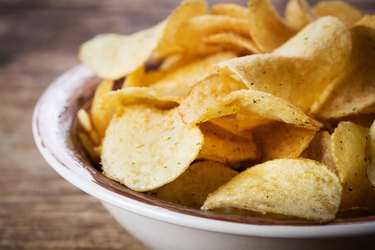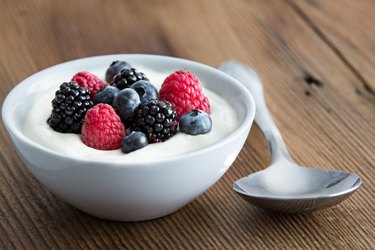
If you're facing a diabetes diagnosis, you're probably also dealing with a swirl of questions about what it means for your health and your lifestyle. Not least among them might be, simply: What do I eat?
And it's an important one. While not the only factor, your diet is crucial to managing type 2 diabetes — and the sooner you adopt a healthy eating plan, the better.
Here, dietitians who specialize in diabetes break down everything you need to know about the condition, including how it develops (and how food plays a role in that) as well as what you should and shouldn't eat if diagnosed.
Quick note: Type 1 diabetes is an autoimmune condition that must be treated with insulin therapy, while type 2 often can be managed with lifestyle changes alone (though some cases will require oral medications and/or insulin therapy as well). This story focuses on dietary choices for individuals at risk of or diagnosed with type 2 diabetes.
Understanding Food's Role in Diabetes
Here's how things go normally: When you eat a bowl of pasta, for example, the carbohydrates get broken down into a simple sugar called glucose in the digestive tract and then absorbed into the bloodstream.
This triggers the pancreas to release a hormone called insulin. Insulin helps the body use glucose for energy by acting like a key that opens cells so that the glucose can enter.
Before a person develops type 2 diabetes, they become insulin resistant. With insulin resistance, the insulin "keys" are still there, but they don't work like they used to, explains Joyce Patterson, MPH, RDN, registered dietitian and diabetes educator at Michigan Medicine's Adult Diabetes Education Program. As a result, the cells do not let in glucose as readily. Instead, glucose stays in the bloodstream, driving up blood sugar levels.
High blood sugar levels stimulate the pancreas to produce more and more insulin. Over time, the organ becomes overwhelmed, and the body's cells become increasingly resistant to insulin.
Prediabetes — the phase before type 2 diabetes develops — is marked by higher-than-normal blood sugar levels and insulin resistance, Patterson says.
"Prediabetes progresses to type 2 diabetes when insulin production starts to wear out and the pancreas is unable to produce enough insulin (this is called insulin insufficiency)," she explains. "In many cases of type 2 diabetes, there is a combination of insulin resistance and insulin insufficiency."
Related Reading
The Connection Between Diet and Diabetes Risk
Now we know how type 2 diabetes develops, but what actually causes it?
No one knows for sure, unfortunately, but we do know there are two types of risk factors: modifiable and non-modifiable.
Non-modifiable factors are those you can't control. According to the Centers for Disease Control and Prevention, these include:
- Genetics: You have an immediate family member with the disease and/or you're part of certain racial or ethnic groups: African American, Hispanic or Latino, Native American, Native Alaskan, Asian American, Pacific Islander
- Age: Your risk increases markedly after age 45
- Polycystic Ovary Syndrome
- History of Gestational Diabetes
Modifiable risk factors are those you can control, and they include being overweight, being physically active less than three times per week and having unhealthy eating habits.
A higher intake of refined carbs and sugary foods is linked to type 2 diabetes. One meta-analysis, published May 2015 in the Journal of Diabetes Investigation, found that people who regularly drink sugar-sweetened beverages have about a 25 percent higher risk of developing type 2. And another, published February 2013 in PLOS One, found a strong link between sugar intake and diabetes regardless of a person's total calorie intake, body weight, alcohol consumption or exercise habits.
Research published August 2018 in the journal Diabetes Care also showed that a diet high in saturated fat (found in foods like processed meats, burgers, fried foods, cheese and butter) may contribute to the development of insulin resistance.
What's more, certain nutrients in produce are linked to lowering your risk of the condition. Eating more fruits and vegetables is associated with preventing the development of type 2 diabetes, per a July 2020 study in BMJ, and researchers think these benefits are due to the vitamin C and carotenoids in plant foods.
"Overall, a well-balanced diet that is nutrient-rich, high in plant foods and low in processed foods, refined carbs and added sugars can help keep the body healthy," Patterson says.
When it comes to designing a healthy meal plan, there's no single "type 2 diabetes diet." In fact, a May 2019 consensus report published in the American Diabetes Association's Diabetes Care journal notes: "a 'one-size-fits-all' eating plan is not evident for the prevention or management of diabetes and it is an unrealistic expectation given the broad spectrum of people affected by diabetes."
Instead, experts encourage following general healthy eating guidelines that support blood sugar control. More on that below.

The Best Foods for People With Diabetes
Redesigning your diet may sound intimidating, but it doesn't have to be. Resources like the USDA's MyPlate can help you modify your meals.
"This method emphasizes a large portion of non-starchy vegetables, lean or plant-based protein and portion-controlled carbs or starchy foods," says Patterson.
Ideally, your plate should have 25 percent lean protein, 25 percent high-quality carbohydrates and 50 percent non-starchy vegetables. (For a better idea on what that looks like, check out the sample meal plan below.)
Non-Starchy Vegetables
- Leafy greens
- Broccoli
- Cabbage
- Cauliflower
- Brussels sprouts
- Beets
- Carrots
- Eggplant
- Mushrooms
- Onions and garlic
- Peppers
- Tomatoes
- Zucchini
Lean Protein
- Legumes (beans, peas, lentils)
- Nuts and nut butters (with no sugar added)
- Tofu
- Tempeh
- Fish and seafood (tuna, salmon, tilapia, shrimp, scallops)
- Poultry without the skin (chicken, turkey)
- Low-fat dairy (cottage cheese, yogurt)
- Eggs
Contrary to popular belief, people with diabetes don't have to scrap carbs from their diet.
"Carbs provide glucose, which is a primary fuel source for the body, especially for the brain and for exercising muscle," says Patterson.
People with diabetes should focus on quality and timing. So instead of avoiding these foods altogether, choose carbs high in fiber and space out consumption over the course of the day.
High-Fiber Carbs
- Whole grains: Brown rice, oatmeal, popcorn, whole-wheat bread and pasta
- Fruit: Fresh, frozen or canned without any added sugars
- Starchy vegetables: Potatoes, pumpkin, corn, squash
- Legumes: Beans, peas, lentils, soybeans
To prevent blood sugar levels from dropping too low (a condition called hypoglycemia), aim to include a healthy balance of complex carbohydrates, fiber-containing foods, lean protein and healthy fats at every meal.
"These foods stabilize blood sugar and provide a slow, steady release of energy throughout the day," says Despina Hyde Gandhi, RDN, a registered dietitian and certified diabetes educator at NYU Langone Health.
Healthy Fats
- Olive and canola oil
- Avocado
- Fatty fish like salmon
- Chia and flax seeds
- Nuts

The Worst Foods for People With Diabetes
No big surprises here: "Limit or minimize added or refined sugars," Patterson recommends, including:
- Desserts
- Soda
- Juice
- White bread and pasta (and other foods made with white flour)
- White rice
- Packaged snack foods
- Sugary breakfast cereals
- Some frozen meals
These are not a good source of nutrients and tend to be full of empty calories, Gandhi says.
"These foods often contain simple sugars and are low in fiber. As a result, they digest quickly and rapidly spike blood sugar, leading it to then drop afterward," she says. "This can leave a person hungry or with symptoms of low blood sugar, which causes them to reach for a snack — and then the cycle can repeat itself."
Make an effort to drive down the amount of saturated fat on your plate, too, by limiting the following:
- Cheese
- Butter
- Processed meats (ham, bacon, hot dogs, sausage, pepperoni)
- Fattier cuts of red meat (beef, lamb, pork, veal)
Do your best to break up with sugar-sweetened beverages, or SSBs. According to Harvard's T.H. Chan School of Public Health, sugar-rich drinks are the single biggest contributor of calories and added sugar in the American diet.
To drive down your SSB intake, nix sweetened coffee drinks and iced teas, sodas, juices and sports/energy drinks that can quickly raise blood sugar levels without actually filling you up.
If you're in need of a little sweetness in your morning cup of joe, it's OK to add a small amount of a natural sweetener like stevia to your cup. The FDA currently regards sweeteners like stevia as GRAS, or generally recognized as safe.
Just try not to lean on sugar substitutes too much. Research suggests sweeteners may actually heighten sugar cravings, according to Harvard Health Publishing.
What's more, sugar alcohols (which differ from artificial sweeteners in that they do contain some calories and carbs) like xylitol can bring on uncomfortable GI symptoms such as gas, bloating and diarrhea for some people.

If you're in need of some diabetes-friendly recipes, you're in luck. The American Diabetes Association's Diabetes Food Hub contains more than 900 recipes that follow the guidelines outlined above — and they even include meals like chipotle BBQ tacos and chocolate-banana muffins.
"When you look at the recipes, you will see that there is quite a bit of flexibility and variety that can fit into a healthy diet," says Patterson. And, as a bonus: "These recipes and nutrition recommendations are not just appropriate for patients with diabetes, but are healthy choices for most people." In other words, your family and loved ones can reap the benefits of eating this way, too.
Of course, calorie needs vary from person to person depending on factors like age, height and physical activity level. But below is a simple meal plan you can use as a framework for healthy eating.
Breakfast:
- 1 scrambled egg with 1 cup spinach
- 1 slice whole-wheat toast with 1 tablespoon almond butter
- 1 small apple or other fruit
- Coffee with a splash of low-fat milk
Lunch:
- Mixed greens topped with a homemade lean turkey burger, ¼ cup lentils, tomatoes, cucumbers and radishes; olive oil and vinegar dressing
Snack:
- ½ cup plain, low-fat Greek yogurt with ½ cup berries and cinnamon
Dinner:
- 4-6 ounces baked salmon
- 1 small baked sweet potato
- 2 cups steamed broccoli
Tip
Contact a registered dietitian to discuss your personal nutrition needs and craft a healthy and safe meal plan.
How Diet Changes Can Help Manage Type 2 Diabetes
The goal of making these smart dietary changes is to keep your blood sugar in check, which can help mitigate the more serious symptoms and side effects of type 2 diabetes.
Hemoglobin A1c, or HbA1c, is a blood marker that indicates long-term blood sugar control. Basically, HbA1c describes how high or low an individual's blood sugar levels have been over the past three or so months (as opposed to a fasting or random blood test that only gives you a right-here-right-now reading).
For people with type 2 diabetes, an HbA1c goal of less than 7 percent is recommended. For reference, those who don't have diabetes typically have an HbA1c level of less than 5.7 percent, while people with prediabetes tend be somewhere in the 5.7 to 6.4 percent range.
One important note: "The A1C goal may be personalized if there are other risks or comorbidities to consider," explains Patterson. "For example, a higher goal may be necessary if the patient experiences frequent low blood sugars, if they are older or if they have multiple conditions that make it difficult to maintain a lower A1C."
Other management tactics address a person's pre-prandial (before eating a meal) and post-prandial (after eating a meal) plasma glucose levels.
"We aim for pre-prandial blood glucose to be between 80 and 130 milligrams per deciliter and post-prandial glucose to be less than 180 milligrams per deciliter," Gandhi says.
Maintaining healthy blood pressure and blood lipid levels is also important to lower the risk of diabetes-related complications like heart disease and kidney damage.
Monitoring your blood sugar, eating a healthy diet, staying physically active and taking the appropriate medications are all important steps you can take to meet these goals.